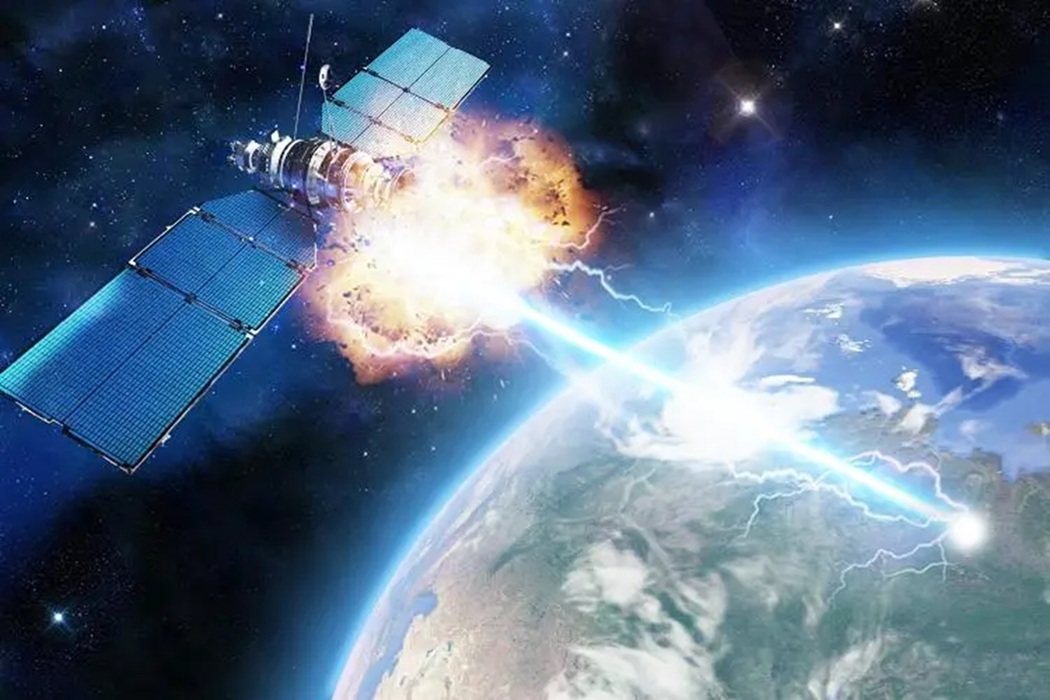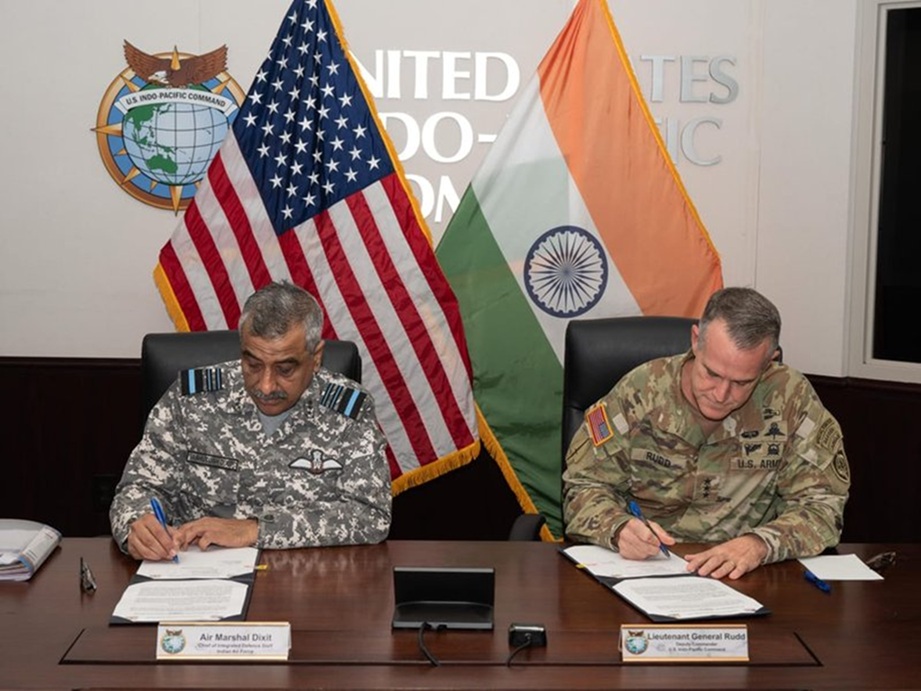Satellite warfare in the Indo-Pacific is characterised by heightened geopolitical competition, particularly between the U.S. and China, leading to the development and deployment of counter-space and electronic warfare capabilities. The establishment of collaborations like the QUAD aims to counter potential threats and enhance space security for a range of national interests. But the ongoing trade war between the US and the rest of the world may become an impediment to QUAD in future. India should explore an independent strategy for the future.
Introduction
The Indo-Pacific security environment has traditionally been conceptualised in maritime and aerial terms: the struggle for naval dominance across the Indian Ocean and the Pacific littorals, and the competition for air superiority over contested zones. Yet in the twenty-first century, this geography of contestation has expanded into the high frontier of outer space. Satellites, once the benign instruments of meteorology, cartography, and communication, are today indispensable nodes in the architecture of modern warfare. They enable precision strike capabilities, global navigation, battlefield networking, and real-time surveillance.
The militarisation of space is no longer a speculative debate but an observable reality. The United States has established a dedicated Space Force; China has tested anti-satellite (ASAT) weapons and constructed an independent navigation system, BeiDou; Russia has refined non-kinetic jamming and cyber intrusion techniques. In such an environment, India—an aspiring great power with both continental and maritime security imperatives—cannot remain a passive observer. For New Delhi, the challenge is not whether to prepare for satellite warfare, but rather how to articulate a counterspace doctrine that safeguards its national assets, deters adversaries, and contributes to the sustainability of the orbital domain.
The Strategic Context: Space as the Fifth Domain of Warfare
Space has increasingly been recognised as the “fifth domain of warfare,” complementing land, sea, air, and cyber. This conceptualisation has emerged from two interrelated dynamics. First, technological dependence on space assets has deepened to the point that military operations without space-enabled Intelligence, Surveillance and Reconnaissance (ISR) or satellite-based navigation appear archaic. Second, the vulnerabilities of space have become more apparent: satellites, despite their sophistication, remain fragile and predictable targets, orbiting along known trajectories.
The militarisation of space has unfolded in distinct phases. During the Cold War, the United States and the Soviet Union experimented with kinetic ASAT systems and deployed early warning satellites, yet refrained from large-scale deployment due to the logic of mutual vulnerability. In the post-Cold War era, however, space has transformed into a seamless extension of terrestrial conflict. The United States’ establishment of the Space Force in 2019, China’s successful destruction of a weather satellite in 2007 using a direct-ascent interceptor, and Russia’s sophisticated non-kinetic counterspace arsenal all illustrate the centrality of space control to strategic advantage.
For the Indo-Pacific, this is not an abstract theoretical development. The region’s balance of power is increasingly mediated by space-enabled systems. China’s BeiDou constellation supports precision targeting and enhances its maritime domain awareness, particularly across the South China Sea and Indian Ocean. In contrast, the United States, Japan, and Australia collaborate to create redundancy and resilience across allied networks. India’s position is unique: it must deter a technologically advanced China, remain vigilant against Pakistan’s asymmetric capabilities, and simultaneously coordinate with like-minded partners—all while maintaining its traditional commitment to strategic autonomy.
India’s Counterspace Journey
India’s tryst with space began in the 1960s with a civilian developmental orientation, spearheaded by the Indian Space Research Organisation (ISRO). The emphasis was on communication satellites, meteorology, and disaster management. However, the limitations of such an approach became starkly evident during the 1999 Kargil War, when Indian forces found themselves disadvantaged by the lack of dedicated satellite imagery. This experience accelerated the integration of space assets into national security planning.
The defining watershed arrived in March 2019, when India conducted Mission Shakti, successfully destroying a live satellite in Low Earth Orbit (LEO) using a direct-ascent kinetic interceptor. This test demonstrated not only technological maturity but also India’s willingness to signal deterrence in the space domain. Critics highlighted the creation of orbital debris, yet New Delhi underscored its commitment to responsible behaviour by noting the low-altitude nature of the test, which ensured debris would decay quickly.
Institutionally, India has since established the Defence Space Agency (DSA) and the Defence Space Research Organisation (DSRO). These bodies are tasked with operationalising counterspace capabilities, strengthening coordination between the military and the civilian space programme, and exploring emerging technologies. Together, they represent a shift from passive reliance on satellites as force multipliers to an active posture of space denial and resilience.
Typology of Counterspace Capabilities
Counterspace capabilities can be broadly divided into four categories, each with distinct strategic implications:
- Kinetic Physical – Direct-ascent ASAT weapons and co-orbital interceptors, which physically destroy satellites. India’s Mission Shakti demonstrated this capability, but kinetic methods risk debris generation and escalation.
- Non-Kinetic Physical – Directed-energy weapons such as lasers or high-powered microwaves, capable of dazzling sensors or damaging components without creating debris. These allow more reversible effects.
- Electronic Warfare – Jamming or spoofing satellite communication and navigation signals. This form of counterspace warfare is already within India’s capabilities and can be deployed in localised theatres such as Ladakh or the Indian Ocean.
- Cyber Operations – Attacks on the command-and-control infrastructure of satellites, which can degrade or disable functionality. While less visible than kinetic methods, these can be highly disruptive and offer deniability.
India’s long-term resilience will depend less on spectacular demonstrations of kinetic destruction and more on the refinement of non-kinetic and electronic warfare tools that allow reversible, controlled effects. Such capabilities not only mitigate escalation risks but also position India as a responsible actor in international forums.
Doctrinal Integration: From Space Support to Space Control
India’s military doctrine in space has thus far been defensive: leveraging satellites to support terrestrial operations in communications, reconnaissance, and navigation. Yet this paradigm must evolve. Deterrence in the space domain requires a two-pronged approach: resilience and denial.
- Resilience entails redundancy, hardening of satellites against jamming, and the capacity for rapid-launch replacement of lost assets through small satellites.
- Denial refers to the ability to disrupt or disable adversary satellites that support hostile operations.
Here, a doctrinal tension emerges. India’s long-standing No First Use (NFU) nuclear policy does not translate neatly into the space domain. In a high-intensity maritime conflict, for instance, in the Andaman Sea, pre-emptive denial of Chinese ISR capabilities might prove essential to Indian survivability. Similarly, space-based ISR is critical for monitoring Chinese naval activity through chokepoints such as the Malacca Strait. To remain doctrinally relevant, India must therefore integrate space control into joint force planning while carefully managing escalation risks.
Geopolitical Dynamics and Partnerships
India’s counterspace posture is not developed in isolation; it is embedded within a broader constellation of partnerships and rivalries. China remains the pacing threat, possessing a diversified counterspace arsenal that includes kinetic, electronic, and cyber capabilities.
At the same time, partnerships offer opportunities for resilience. The US–India Initiative on Critical and Emerging Technologies (iCET) promises enhanced cooperation in space situational awareness (SSA), while Japan’s advanced tracking radars make it a natural partner in monitoring orbital activity. Australia, too, with its southern hemisphere geography, is critical for global SSA coverage.
Yet India is unlikely to join formal alliances akin to NATO or even AUKUS. Strategic autonomy remains a guiding principle. Instead, New Delhi will favour selective interoperability: data-sharing, joint exercises, and cooperative SSA, without binding defence commitments. Such an approach mirrors India’s wider Indo-Pacific posture—engaging deeply with like-minded democracies while preserving flexibility in crisis management.
Historical Parallels: Lessons from the Cold War
The Cold War provides useful historical analogies. Both the United States and the Soviet Union developed extensive ASAT arsenals but refrained from their use due to mutual vulnerability. Destroying satellites would not only degrade the enemy’s capabilities but also expose one’s own systems to retaliation. This “deterrence by vulnerability” continues to resonate today.
However, the analogy has limits. Unlike the bipolarity of the Cold War, the Indo-Pacific presents a multipolar environment with asymmetric capabilities. China’s diversified arsenal gives it escalation dominance in the space domain, a gap India must address rapidly. Moreover, the entanglement of civilian and military satellites today complicates escalation control: attacks on dual-use satellites could have severe political and economic consequences.
Scenario-Based Analysis: Indo-Pacific Flashpoints
Two hypothetical flashpoints illustrate the salience of counterspace warfare for India:
- A Taiwan Strait Crisis – Should China divert naval assets into the Indian Ocean to pressure India, New Delhi might employ counterspace measures to degrade Beijing’s satellite tracking of Indian naval movements. This would complicate Chinese operations, forcing reliance on vulnerable surface and airborne ISR assets.
- A Border Conflict in Ladakh – In a high-intensity standoff, India might jam BeiDou signals over the Himalayas, thereby disrupting Chinese artillery and drone operations. Such an approach would impose operational costs without crossing the threshold of kinetic escalation.
These scenarios highlight that counterspace is not a niche capability. It is a cross-domain enabler that shapes strategic manoeuvre and deterrence.
Diplomatic Challenges and Legal Constraints
The legal architecture governing outer space remains underdeveloped. The Outer Space Treaty (1967) prohibits weapons of mass destruction in orbit but does not ban conventional ASAT weapons. As a result, states operate in a legal grey zone. India’s Mission Shakti was criticised for creating debris, yet New Delhi defended its compliance with international law.
Diplomatic costs, however, cannot be ignored. Allies such as the United States and Japan may be wary of actions that destabilise the orbital commons. Consequently, India must balance deterrence with reputation. Emphasising non-debris-producing technologies, investing in transparency, and engaging proactively in forums such as the UN Committee on the Peaceful Uses of Outer Space (COPUOS) can allow India to signal responsibility while pursuing deterrence.
Conclusion
India’s counterspace strategy in the Indo-Pacific is neither a luxury nor an optional addendum to its defence posture—it is a necessity. The space domain has become the nervous system of modern warfare, linking operations across land, sea, and air. Any major conflict in the Indo-Pacific will inevitably involve attempts to disrupt or degrade satellites.
For India, the challenge is threefold:
- To build resilient architectures that can absorb losses and continue functioning.
- To develop non-debris-producing denial capabilities that credibly deter adversaries without undermining orbital sustainability.
- To integrate counterspace doctrine into joint force planning in a manner that preserves strategic autonomy while reassuring partners.
The stakes could not be higher. As satellites evolve from passive enablers into active instruments of war, those who can safeguard their own constellations while credibly threatening an adversary’s will define the strategic balance of the twenty-first century. India’s task is to chart an independent course responsibly—deterring adversaries, preserving autonomy, and shaping norms for a contested but sustainable orbital future.
Title image courtesy: The Sun
Disclaimer: The views and opinions expressed by the author do not necessarily reflect the views of the Government of India and Defence Research and Studies









